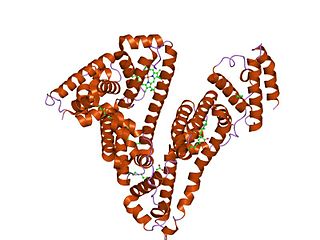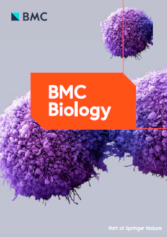
Structural biology is a field that is many centuries old which, as defined by the Journal of Structural Biology, deals with structural analysis of living material at every level of organization. Early structural biologists throughout the 19th and early 20th centuries were primarily only able to study structures to the limit of the naked eye's visual acuity and through magnifying glasses and light microscopes.

Biophysics is an interdisciplinary science that applies approaches and methods traditionally used in physics to study biological phenomena. Biophysics covers all scales of biological organization, from molecular to organismic and populations. Biophysical research shares significant overlap with biochemistry, molecular biology, physical chemistry, physiology, nanotechnology, bioengineering, computational biology, biomechanics, developmental biology and systems biology.

Membrane proteins are common proteins that are part of, or interact with, biological membranes. Membrane proteins fall into several broad categories depending on their location. Integral membrane proteins are a permanent part of a cell membrane and can either penetrate the membrane (transmembrane) or associate with one or the other side of a membrane. Peripheral membrane proteins are transiently associated with the cell membrane.
BioMed Central (BMC) is a United Kingdom-based, for-profit scientific open access publisher that produces over 250 scientific journals. All its journals are published online only. BioMed Central describes itself as the first and largest open access science publisher. It was founded in 2000 and has been owned by Springer, now Springer Nature, since 2008.

Serum albumin, often referred to simply as blood albumin, is an albumin found in vertebrate blood. Human serum albumin is encoded by the ALB gene. Other mammalian forms, such as bovine serum albumin, are chemically similar.

Carboxysomes are bacterial microcompartments (BMCs) consisting of polyhedral protein shells filled with the enzymes ribulose-1,5-bisphosphate carboxylase/oxygenase (RuBisCO)—the predominant enzyme in carbon fixation and the rate limiting enzyme in the Calvin cycle—and carbonic anhydrase.
PLOS Computational Biology is a monthly peer-reviewed open access scientific journal covering computational biology. It was established in 2005 by the Public Library of Science in association with the International Society for Computational Biology (ISCB) in the same format as the previously established PLOS Biology and PLOS Medicine. The founding editor-in-chief was Philip Bourne and the current ones are Feilim Mac Gabhann and Jason Papin.
The EM Data Bank or Electron Microscopy Data Bank (EMDB) collects 3D EM maps and associated experimental data determined using electron microscopy of biological specimens. It was established in 2002 at the MSD/PDBe group of the European Bioinformatics Institute (EBI), where the European site of the EMDataBank.org consortium is located. As of 2015, the resource contained over 2,600 entries with a mean resolution of 15Å.
eEF-1 are two eukaryotic elongation factors. It forms two complexes, the EF-Tu homolog EF-1A and the EF-Ts homolog EF-1B, the former's guanide exchange factor. Both are also found in archaea.
BMC Systems Biology was an open access peer-reviewed scientific journal that covered research in systems biology. Filling a gap in what was a new research field, the journal was established in 2007 and is published by BioMed Central. Part of the BMC Series of journals, it had a broad scope covering the engineering of biological systems, network modelling, quantitative analyses, integration of different levels of information and synthetic biology. In January 2019 the Editorial Board was informed that the journal was closing and no more submissions would be accepted after March 1. The last articles were published on 5 April 2019, but content is still archived in perpetuity from the homepage and PubMed Central.

BMC Bioinformatics is a peer-reviewed open access scientific journal covering bioinformatics and computational biology published by BioMed Central. It was established in 2000, and has been one of the fastest growing and most successful journals in the BMC Series of journals, publishing 1,000 articles in its first five years.

BMC Biology is an online open access scientific journal that publishes original, peer-reviewed research in all fields of biology, together with opinion and comment articles. The publication was established in 2003. The journal is part of a series of BMC journals published by the UK-based publisher BioMed Central, owned by Springer Nature. The journal has an international editorial board of researchers and editorial offices in London and New York.

Bacterial microcompartments (BMCs) are organelle-like structures found in bacteria. They consist of a protein shell that encloses enzymes and other proteins. BMCs are typically about 40–200 nanometers in diameter and are made entirely of proteins. The shell functions like a membrane, as it is selectively permeable. Other protein-based compartments found in bacteria and archaea include encapsulin nanocompartments and gas vesicles.

(S)-Canadine, also known as (S)-tetrahydroberberine and xanthopuccine, is a benzylisoquinoline alkaloid (BIA), of the protoberberine structural subgroup, and is present in many plants from the family Papaveraceae, such as Corydalis yanhusuo and C. turtschaninovii.
BMC Ecology and Evolution, previously BMC Evolutionary Biology (2001–2020), is a peer-reviewed open access scientific journal covering all fields of evolutionary biology, including phylogenetics and palaeontology. It was established in 2001 and is part of a series of BMC journals published by BioMed Central.

The European Conference on Computational Biology (ECCB) is a scientific meeting on the subjects of bioinformatics and computational biology. It covers a wide spectrum of disciplines, including bioinformatics, computational biology, genomics, computational structural biology, and systems biology. ECCB is organized annually in different European cities. Since 2007, the conference has been held jointly with Intelligent Systems for Molecular Biology (ISMB) every second year. The conference also hosts the European ISCB Student Council Symposium. The proceedings of the conference are published by the journal Bioinformatics.

Corynebacterium glutamicum is a Gram-positive, rod-shaped bacterium that is used industrially for large-scale production of amino acids. While originally identified in a screen for organisms secreting L-glutamate, mutants of C. glutamicum have also been identified that produce various other amino acids.










